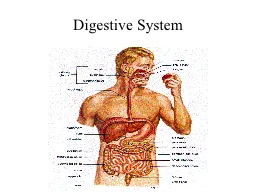

To assimilate food in bowels The Process of Digestion Digestion The process of breaking down food into its MOLECULAR and CHEMICAL components so that these nutrient molecules can cross cell membranes to be used for cellular processes ID: 920773
Download Presentation The PPT/PDF document "Digestive System Digestive" is the property of its rightful owner. Permission is granted to download and print the materials on this web site for personal, non-commercial use only, and to display it on your personal computer provided you do not modify the materials and that you retain all copyright notices contained in the materials. By downloading content from our website, you accept the terms of this agreement.
Slide1
Digestive System
Slide2Digestive
To assimilate
food in
bowels
Slide3The Process of Digestion
Digestion:
The process of breaking down food into its
MOLECULAR
and
CHEMICAL
components so that these nutrient molecules can cross cell membranes to be used for cellular processes.
Slide4Ingestion
-an active voluntary process in which food is placed in the mouth
Propulsion-
the movement of food through the digestive tract
Mechanical Digestion
-physical fragmentation of food
Chemical Digestion
-the process by which large food molecules are broken down into smaller building blocks by enzymes
Absorption-
the transfer of food molecules from the digestive tract into the bloodstream
Elimination/Defecation
-the elimination of indigestible residues
Slide5Two PartsAlimentary CanalAliment = nourishAlso called gastrointestinal tractMouth
Pharynx
esophagus,
Stomach
Small intestines
Large intestine
anus
Accessory digestive organs (next set of notes!)
Slide6Digestive System Pathway
It can take food from 8 to 48 hours to pass through your digestive tract from mouth to anus!
http://health.howstuffworks.com/adam-200086.htm
Slide7A. Mouth
MECHANICAL
-chewing
CHEMICAL
-amylase, an enzyme breaks down carbohydrates
1. Tongue pushes chewed food (bolus) into the throat
2. Epiglottis folds over larynx at entrance of trachea
Slide8Pig
Slide9Pig
Equine Endoscopy
Epiglottis is tongue-like structure
Slide10Starches and sugars are both carbohydrates…
As you chew a cracker enzymes in your saliva (amylase) break down the complex polysaccharide (starch) in the cracker and you begin to notice the sweet taste of sugar. This is an example of a chemical reaction that is a part of your bodies’ metabolism, in which food is converted to usable energy for your cells.
Slide11B. Pharynx/
Esophagus
PERISTALSIS
, rhythmic contractions of the smooth muscles pushes food down.
The
Cardioesophageal
Sphincter
, a valve at the end of the esophagus controls bolus entry into stomach
Slide12C. Stomach
1.Stomach walls contract to churn food (
MECHANICAL DIGESTION
)
2. Hydrochloric acid and pepsin (enzyme) break down
PROTEINS
(Chemical Digestion)
3. Creates
CHYME
(processed food – or what you puke)
.
Slide13Slide14Slide15When full, stomach can hold about 1 gallon of foodPyloric sphincter (valve) allows flow into the intestines
Slide16D. Small Intestine
1.Digestion of
FATS
begins, while carbohydrates and proteins continue. (Chemical Digestion)
2.Nutrient
ABSORPTION
3. Small diameter-7 meters long.
Slide17Has three distinct partsDuodenum : twelve fingers width longfood from the stomach is mixed with enzymes from the pancreas and bile from the gallbladder. The enzymes and bile help break down foodJejunum: emptyinside walls absorb the food's nutrients
Slide18Ileum: twisted intestine absorbs bile acids, which are returned to the liver to be made into more bileabsorbs vitamin B 12 , which the body uses to make nerve cells and red blood cellsIleocecal
valve – joins small to large intestine
Slide19Slide20e. The
small intestine is lined with
VILLI
, which increase the surface area and absorption rates.
Slide21Surface of Stomach
Slide22Surface of Stomach
Slide23E. Large Intestine
WATER
and water-soluble vitamins are absorbed by the large intestine.
Approximately
1.5 meters long-large diameter.
Slide24F. AnusExit/opening for the removal of feces
Slide25Homework
Slide26Aliment = nourish or food. Why is the alimentary canal thus named?Because it nourishes the body by breaking food down in to usable pieces and getting rid of waste
Slide27Label the following “pieces” of the oral cavity.
Hard
palete
Soft palate
teeth
tongue
epiglottis
trachea
esophagus
Slide28Explain how bolus moves from the mouth to the stomach.The process of peristalsis – alternating waves of contraction and relaxation of esophageal muscles
Slide29Label the parts of the stomach on the diagram below.
esophagus
fundus
Longitudinal layer
Circular layer
Oblique layer
serosa
Greatuer
curvature
Pyloric
antrum
duodenumPyloric sphincterLesser curvatureCardioesophageal sphincter
Slide30What happens when the stomach is empty?It collapses in on itself
Slide31What happens to food in the stomach? What role do the gastric juices play?Physical: breakdown of food Churning, mixing, pummelingChemical: continued breakdown of carbohydrates and beginning breakdown of proteins
Slide32What is the role of the mucus lining of the stomach?Protects the stomach muscles from being “eaten” by stomach acids
Slide33Why is the small intestine considered the body’s major digestive organ?Because chemical digestion really begins here.Nearly all food absorption occurs in small intestines
Slide34Why is the small intestine well suited for its function?Because it has three structures that increase absorptive surface:Microvilli (finished digestion of proteins and carbohydrates)Villi - (rich in capillaries)
Circular folds – (increases surface area so there are more villi)
Slide35What are the villi and why are they important? Small fingerlike projections which are rich in capillaries allowing for nutrients to pass from the small intestines to the bloodstream
Slide36Why does the large intestine not have villa?Because only water and water soluble vitamins are absorbed through the large intestine walls